The Cathedral Window Quilt pattern is a traditional design featuring a stained glass-like appearance, created using bias edges and a window frame concept. Download the PDF for detailed instructions.
Overview of the Cathedral Window Quilt Design
The Cathedral Window Quilt Design is a timeless pattern resembling stained glass windows, creating a visually striking effect. It features fabric squares arranged to mimic window panes, with contrasting frames and sashing. The design relies on bias-cut edges and precise stitching to achieve its signature look. The pattern is versatile, allowing quilters to experiment with color and fabric choices. Suitable for both traditional and modern aesthetics, it offers a unique way to showcase intricate details. A free PDF tutorial provides step-by-step guidance, making it accessible to all skill levels.
Historical Background of the Pattern
The Cathedral Window Quilt pattern draws inspiration from the stunning stained-glass windows of historic cathedrals, reflecting a blend of art and spirituality. Originating in the early 20th century, it was popularized by quilters seeking to replicate the intricate beauty of religious architecture. The design has evolved over time, with modern adaptations incorporating diverse fabrics and techniques. The pattern’s enduring appeal lies in its ability to combine traditional craftsmanship with creative expression. A detailed PDF guide offers insights into its history and construction, preserving its legacy for future generations.
Popularity and Unique Features
The Cathedral Window Quilt pattern has gained immense popularity for its striking resemblance to stained-glass windows, creating a sense of elegance and serenity. Its unique feature is the illusion of “windows” formed by contrasting fabrics, often with a light background and darker framing. This design is versatile, suitable for both traditional and modern aesthetics. Quilters appreciate its challenge and the opportunity to experiment with color combinations. The pattern’s visual appeal makes it a favorite for home decor projects. A detailed PDF guide provides comprehensive instructions for mastering this beloved design, ensuring its continued popularity among quilters of all skill levels.
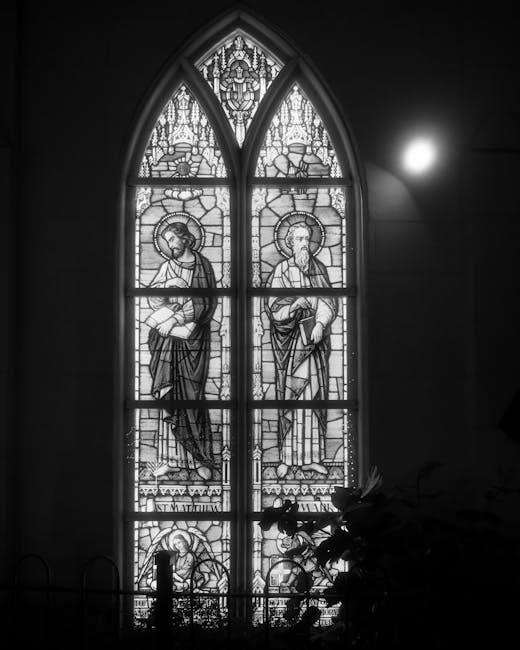
Key Elements of the Cathedral Window Quilt
The Cathedral Window Quilt features intricate windowpane designs, bias-cut edges, and layered fabric frames. It relies on precise stitching and thoughtful fabric contrast to create its signature look.
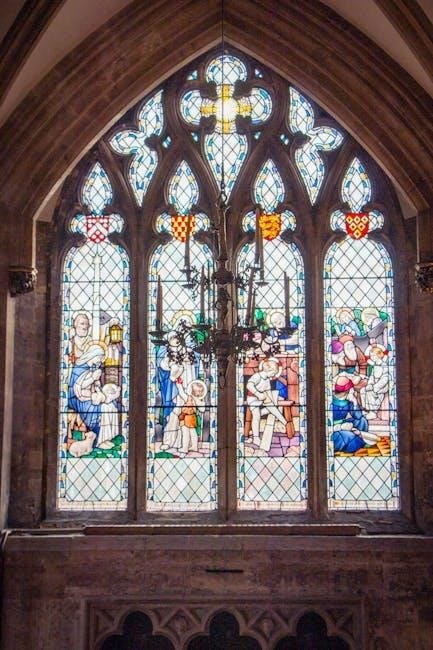
The Role of Bias Edges in the Design
Bias edges are a cornerstone of the Cathedral Window Quilt, allowing fabrics to stretch and curve seamlessly. They enable the creation of smooth, rounded seams that define the quilt’s signature windowpane effect. By cutting fabric on the bias, quilters achieve greater flexibility, making it easier to shape the intricate frames without distorting the material. This technique ensures a crisp, professional finish and enhances the quilt’s dimensional appeal. Properly handled bias edges are essential for maintaining the pattern’s structural integrity and visual harmony, making them a critical element in the design process.
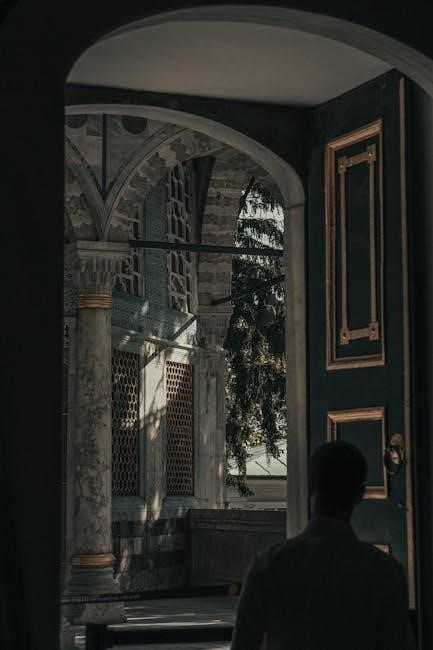
Understanding the Window Frame Concept
The Cathedral Window Quilt’s window frame concept is its defining feature, creating a series of interconnected frames that mimic the look of stained-glass windows. These frames are constructed using strips of fabric, carefully placed to form the illusion of panes. The design relies on strategic placement of light and dark fabrics to create depth and dimension. The frames are typically sewn with a sashing technique, allowing the quilt to expand and contract visually. This concept gives the quilt its signature 3D effect, making the centers of the “windows” appear recessed, much like real glass. The result is a striking, intricate pattern that captivates the eye.
Importance of Color Choice and Fabric Selection
Color choice and fabric selection are pivotal in achieving the Cathedral Window Quilt’s stunning visual impact. High-contrast colors create the illusion of depth, with light fabrics mimicking glass and dark fabrics forming frames. Selecting complementary hues enhances the stained-glass effect, while bold patterns add complexity. Cotton fabrics are ideal for stability and vibrant color retention. Solids highlight the geometric design, whereas subtle prints add texture without overwhelming the pattern. Prewashing fabrics ensures colorfastness and prevents shrinkage. Balancing colors and textures is key to making the quilt visually striking and cohesive, ensuring each “window” stands out beautifully.
Construction Techniques for the Cathedral Window Block
Constructing the Cathedral Window block involves precise techniques to achieve its signature stained-glass effect. The process begins with creating curved window frames, typically using bias strips, which are sewn and pressed to form smooth edges. The frames are then layered over contrasting fabric “glass” pieces, carefully aligned to mimic the look of panes. Sewing the frames in place requires accurate stitching to maintain the block’s symmetry. Pressing seams meticulously ensures a crisp finish. Advanced quilters may use foundation piecing or curved seam techniques for precision. Each block is a mini masterpiece, with careful construction ensuring the quilt’s visual impact and durability.
Materials and Supplies Needed
High-quality fabrics with contrasting colors, rotary cutter, cutting mat, sewing machine, threads, batting, backing fabric, and notions like pins and scissors are essential for success.
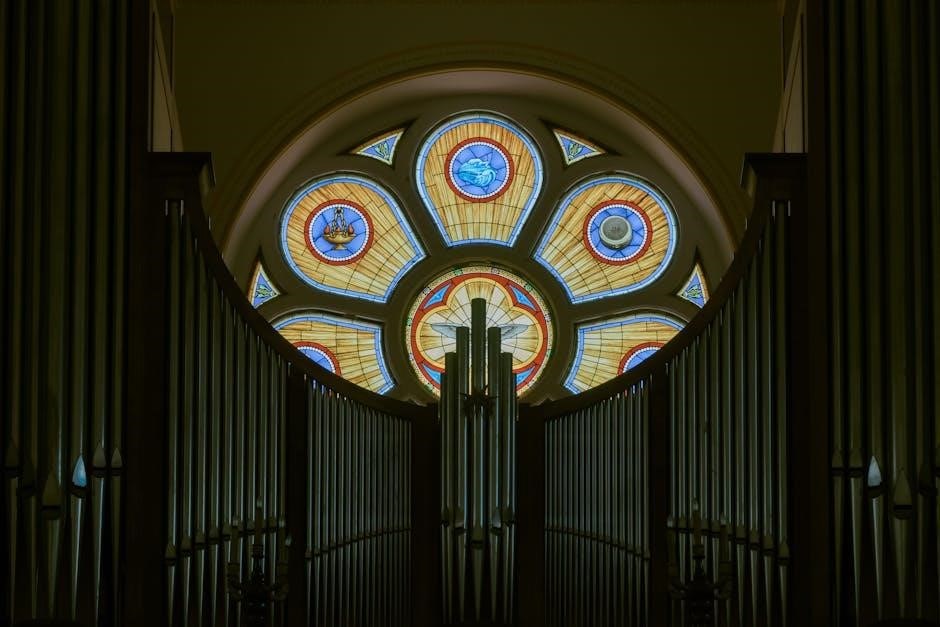
Essential Fabrics for the Quilt
Selecting the right fabrics is crucial for the Cathedral Window Quilt. Use high-quality cotton fabrics to ensure durability and a professional finish. Light, medium, and dark fabrics create contrast, enhancing the window effect. Solids or subtle prints work best for the “glass” panes, while contrasting fabrics define the frames. Pre-wash all fabrics to prevent shrinkage and ensure colors remain vibrant. A balanced mix of colors and textures will bring depth and visual interest to the quilt. Consider using scraps for variety or stick to a cohesive palette for a modern look. Fabric choice directly impacts the quilt’s beauty and functionality.
Tools Required for Precision Cutting and Sewing
To create a Cathedral Window Quilt, essential tools include a rotary cutter, cutting mat, and ruler for precise fabric cutting. Sharp scissors are handy for trimming small pieces. A sewing machine with a walking foot or even-feed feature helps manage thick seams. A seam ripper, pins, and clips are indispensable for aligning and securing fabric. A hot iron and ironing board are crucial for pressing seams flat. Accurate measuring tools, like a seam gauge, ensure consistent stitching. A thimble protects fingers during hand-stitching, while pattern templates aid in achieving the quilt’s signature curved edges. Quality threads and needles complete the toolkit for this intricate design.
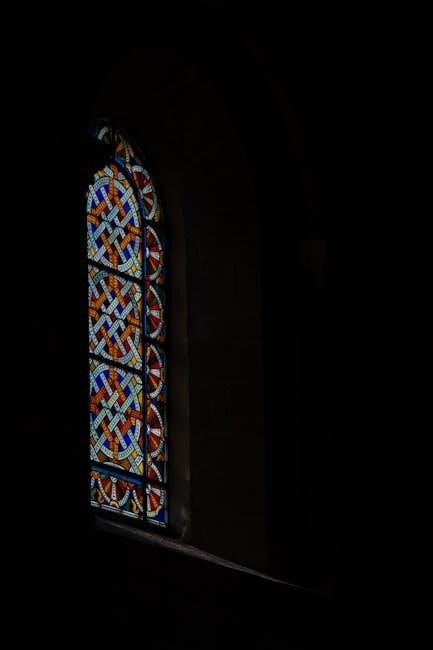
Batting and Backing Materials
Choosing the right batting and backing materials is essential for a Cathedral Window Quilt. Batting provides loft and insulation, with cotton being a popular choice for its breathability and traditional feel. Wool batting offers warmth, while bamboo is eco-friendly and moisture-wicking. For the backing, a single, large piece of fabric is ideal, ensuring stability during quilting. Neutral tones complement the quilt’s intricate design, but bold colors can add a modern twist. Pre-washing these materials ensures they won’t shrink or bleed during finishing, preserving the quilt’s integrity. Properly selected batting and backing enhance both appearance and functionality, making the quilt a lasting treasure.
Thread and Notions
Selecting the right thread and notions is crucial for constructing a Cathedral Window Quilt. Neutral-colored threads blend seamlessly with fabrics, while contrasting threads can highlight stitching details. Cotton or polyester threads are ideal for their durability and smooth stitching. Essential notions include sharp rotary cutters, precision rulers, and thimbles to protect fingers during hand-stitching. Pins and sewing needles in various sizes are also necessary. A walking foot or even-feed attachment on your sewing machine can aid in managing thick seams. Fabric markers or chalk are useful for marking stitching lines, ensuring accuracy in this intricate design. These tools collectively ensure precision and professionalism in the finished quilt.
Step-by-Step Construction Guide
This section provides detailed instructions for creating a Cathedral Window Quilt, covering fabric preparation, stitching techniques, and assembly processes to ensure a professional finish.
Step 1: Cutting the Squares
Begin by cutting squares of fabric according to your pattern specifications. Use a rotary cutter, mat, and ruler for precise cuts. Cut squares in sizes ranging from 6 to 8 inches, depending on the desired block size. Ensure the squares are cut accurately, as this forms the foundation of the Cathedral Window design. Select fabrics with high contrast to enhance the window effect. Cut multiple squares from each fabric to maintain variety and balance. Consider using scraps for a scrappy look or stick to a coordinated palette for a cohesive appearance. Label squares for easy identification during assembly.
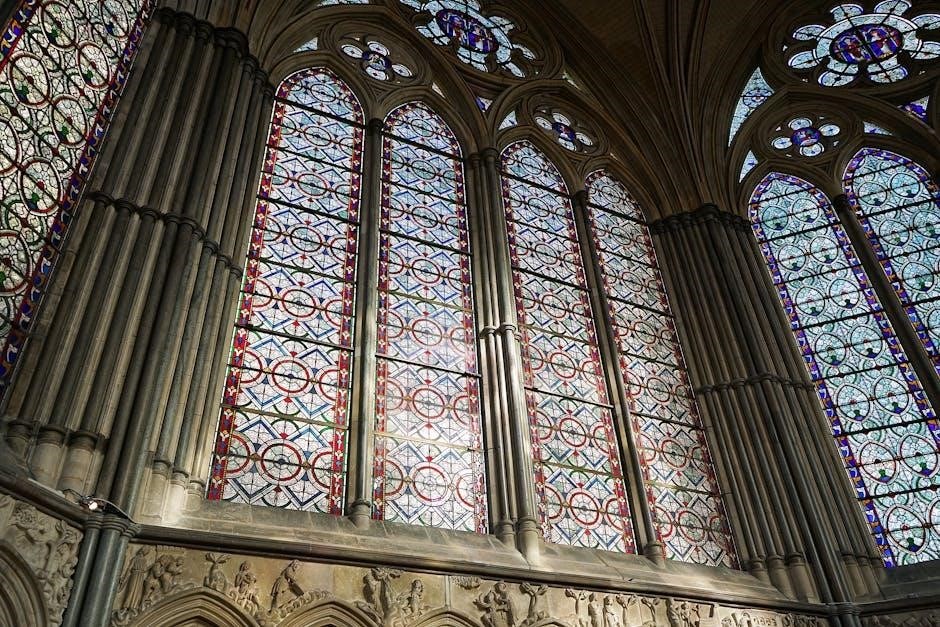
Step 2: Pressing the Edges
After cutting the squares, press the edges to prepare for stitching. Fold and press a 1/4-inch hem along all four sides of each square to create crisp, defined edges. Use steam and a hot iron for sharp creases. This step ensures the fabric lies flat and forms a clean foundation for the Cathedral Window design. Pressing the edges before stitching helps maintain accuracy and prevents fabric distortion. Fold both sides of the square to the center and press again to create a symmetrical frame. This technique is essential for achieving the signature window effect in the quilt blocks. Pressing precisely sets the stage for smooth stitching.
Step 3: Stitching the Window Frames
With the edges pressed, fold the square along the center creases to form the window frame. Stitch along the folded edges using a 1/4-inch seam allowance. Use a straight stitch or a blind hem stitch for this step. Ensure the stitching is precise to maintain the sharp angles of the frame. Backstitch at the beginning and end of each seam for durability. Press the seams flat to create a crisp fold. This step transforms the fabric into the iconic window frame design, setting the foundation for the quilt’s signature look. The stitching should be tight and even to achieve the desired architectural effect.
Step 4: Assembling the Blocks
Once the window frames are stitched, arrange the blocks in the desired layout. Align the edges carefully to ensure symmetry. Place two blocks right sides together, matching the window frame corners. Stitch along the edges with a 1/4-inch seam allowance, using a straight stitch. Press the seams flat, then repeat for all blocks. For accuracy, pin the blocks before sewing to maintain alignment. Continue assembling row by row, ensuring the quilt’s overall design remains balanced. This step requires patience, as precise alignment is key to achieving the quilt’s architectural beauty. The result will be a cohesive and visually striking quilt top.
Step 5: Combining Blocks into a Full Quilt
After assembling individual blocks, arrange them in your desired layout, ensuring a balanced and visually appealing design. Sew the blocks together in rows, aligning the edges carefully to maintain the quilt’s symmetry. Add sashing or borders if desired to enhance the overall size and frame the design. Once the quilt top is complete, layer it with batting and backing fabric. Quilt the layers together using a sewing machine or by hand, following the natural lines of the Cathedral Window design. Finally, bind the edges to finish the quilt, ensuring a professional and polished result. Precision and patience are key in this final step.
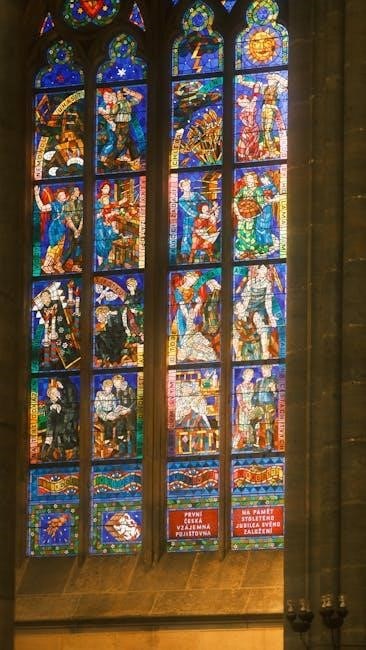
Advanced Techniques for the Cathedral Window Quilt
Explore intricate scrap fabric combinations, add decorative appliqué, or modernize the traditional design with bold colors and contemporary layouts for a unique, personalized quilt.
Incorporating Scrap Fabrics for a Scrappy Look
Incorporating scrap fabrics adds a charming, eclectic vibe to the Cathedral Window quilt. Use small fabric remnants to create a unique, patchwork appearance within each window frame. Varying colors and patterns can add depth and visual interest, while maintaining the quilt’s structural integrity. To achieve a cohesive look, balance bold and neutral scraps. Consider using a unifying fabric for the window frames to tie the design together. This technique is ideal for quilters with leftover materials, allowing them to create something beautiful from scraps. Audition fabrics beforehand to ensure harmony, and don’t hesitate to experiment with fussy-cutting for added visual appeal.
Adding Embellishments and Appliqué
Enhance the Cathedral Window quilt with embellishments and appliqué for a personalized touch. Appliqué can be used to add intricate shapes or motifs within the window frames, creating focal points. Embroidery, beads, or metallic threads can highlight stitching lines or add texture. Consider appliquéing floral patterns or geometric shapes to complement the quilt’s design. These embellishments can be applied before or after assembling the quilt blocks, depending on the desired effect. They add visual interest and make the quilt truly unique. Use these elements sparingly to maintain the quilt’s elegance while showcasing your creativity and attention to detail.
Creating a Modern Twist on the Traditional Design
Modernize the Cathedral Window quilt by experimenting with bold colors, asymmetrical layouts, and contemporary fabric choices. Substitute traditional prints with solids, gradients, or modern geometric patterns for a fresh look. Consider simplifying the window frame structure or adding abstract elements to break from symmetry. Incorporate negative space or minimalist designs to create a sleek aesthetic. Additionally, mixing hand-stitching with machine quilting can add texture and visual contrast. These innovative approaches allow quilters to preserve the pattern’s essence while infusing it with modern style, making the Cathedral Window quilt appeal to a new generation of crafters and homeowners alike.
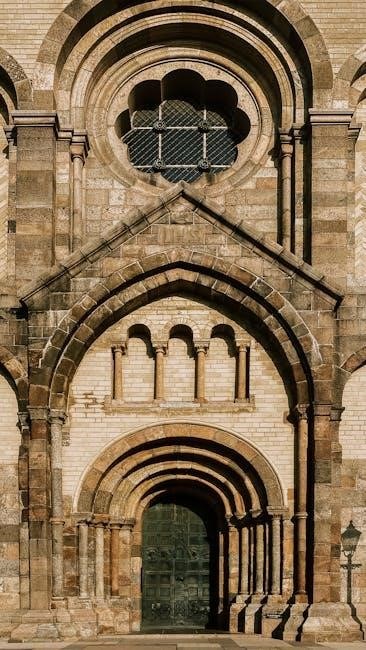
Tips for Beginners
Start with small projects, use accurate cutting tools, and press seams carefully. Practice stitching straight lines and bias edges before assembling blocks. Patience and practice yield perfect results.
Mastering the Bias Edge
Mastery of the bias edge is crucial for the Cathedral Window Quilt. Start by cutting fabric strips on the bias for flexibility. Use a walking foot or Teflon foot for smooth sewing. Press edges before stitching to create sharp folds. Practice sewing curves on scrap fabric to build confidence. Always sew from the center outward to maintain control. Use starch to stiffen fabric for crisp edges. Work slowly, as precision is key. Starting with a straight edge and gradually curving inward helps manage fabric movement. These techniques ensure professional-looking results and a flawless Cathedral Window design.
Avoiding Common Mistakes
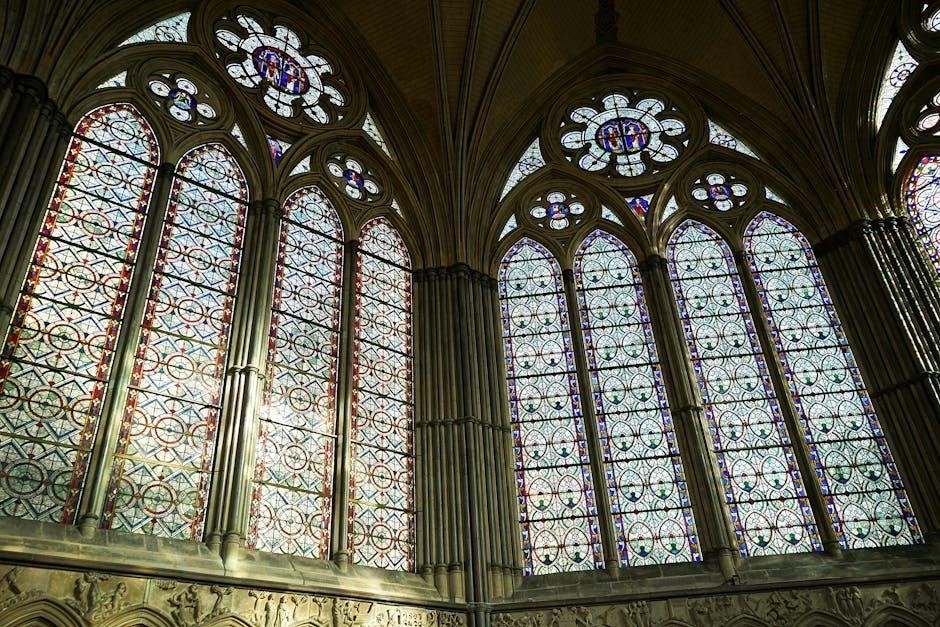
When making a Cathedral Window Quilt, avoid common mistakes by ensuring accurate cutting and stitching. Incorrect seam allowances can distort the window frames, so double-check measurements. Over-stretching bias edges can lead to misshapen blocks; use starch for stability. Inconsistent pressing can disrupt the design, so press as you go. Fabric shifting during sewing is another pitfall; pin carefully and sew slowly. Avoid uneven gathering by using a consistent stitch length. Mistakes in fabric placement can ruin symmetry, so label pieces clearly. Regularly inspect blocks for alignment issues and address them early to maintain the quilt’s integrity and visual appeal.
Time-Saving Tricks
To save time when making a Cathedral Window Quilt, pre-cut all fabrics in bulk to avoid repeated trips to the cutting mat. Use a rotary cutter and mat for precise, quick cuts; Pressing edges in advance can streamline the sewing process. Consider chain piecing to stitch multiple window frames efficiently. Use templates or dies for consistent shapes, reducing cutting time. Sewing in batches and organizing pieces by color or block can also save minutes. Finally, pre-assemble smaller components to make block assembly faster. These tricks help maintain momentum and reduce overall project time without compromising quality.
Resources and Tutorials
Find detailed Cathedral Window Quilt tutorials on Craftsy and YouTube. Download PDF patterns from quilting blogs and Pinterest for visual guides and step-by-step instructions.
Free Cathedral Window Quilt Patterns
Discover free Cathedral Window Quilt patterns in PDF format on various quilting websites and blogs. Platforms like Pinterest and Craftsy often offer downloadable guides. Many designers provide free versions of their patterns, perfect for beginners or those exploring the design. These patterns usually include basic templates and instructions to create a traditional Cathedral Window block. Some websites also offer variations, such as mini quilts or baby quilt sizes. When searching, use keywords like “free Cathedral Window quilt pattern PDF” to find these resources. Always check the skill level and fabric requirements before downloading to ensure it suits your project needs.
Recommended Tutorials and Guides
Enhance your Cathedral Window Quilt journey with detailed tutorials and guides available online. Many quilting experts offer step-by-step PDF instructions, often accompanied by video lessons. These resources provide in-depth guidance on constructing the intricate window frame design, mastering bias edges, and selecting harmonious fabrics. Platforms like YouTube and quilting blogs feature comprehensive tutorials, while websites such as Craftsy and quilting communities share downloadable PDF guides. These tools are perfect for both beginners and experienced quilters looking to refine their skills. They often include tips for avoiding common mistakes and achieving professional finishes. Explore these resources to elevate your Cathedral Window Quilt project.
Online Communities and Forums
Joining online communities and forums is an excellent way to connect with fellow quilters passionate about the Cathedral Window pattern. Platforms like Facebook groups, Reddit’s quilting communities, and specialized forums offer a wealth of knowledge and support. Many members share their experiences, tips, and even PDF patterns for the Cathedral Window quilt. These spaces are ideal for asking questions, showcasing your work, and gaining inspiration. Active communities like Quilting Hub or Quilter’s Forum often host discussions dedicated to this pattern, providing a collaborative environment to learn and grow as a quilter. Engage with these groups to enhance your creative journey and troubleshooting skills.
The Cathedral Window quilt pattern is a timeless, intricate design that combines beauty and functionality. Its versatility makes it a cherished project for quilters of all skill levels.
Final Thoughts on the Cathedral Window Quilt
The Cathedral Window quilt is a stunning, intricate design that offers a rewarding challenge for quilters. Its unique windowpane effect creates a sense of depth and elegance, making it a standout piece in any home. While it requires precision and patience, the end result is well worth the effort. Quilters of all levels can enjoy this pattern, as it allows for both traditional and modern interpretations. With the right tools and a bit of practice, anyone can master the Cathedral Window technique and create a beautiful, lasting heirloom.
Encouragement to Try the Pattern
Embarking on a Cathedral Window quilt is a rewarding journey for quilters of all skill levels. The pattern’s timeless beauty and versatility make it a project worth undertaking. Whether you’re a beginner or an experienced sewer, the process of creating interlocking windows offers a sense of accomplishment. Start small with a single block to gain confidence, then expand your skills. With patience and practice, you’ll master the bias edges and stitching techniques. Don’t hesitate to explore scrap fabrics or modern twists to make the design uniquely yours. The end result will be a stunning quilt that showcases your creativity and dedication.